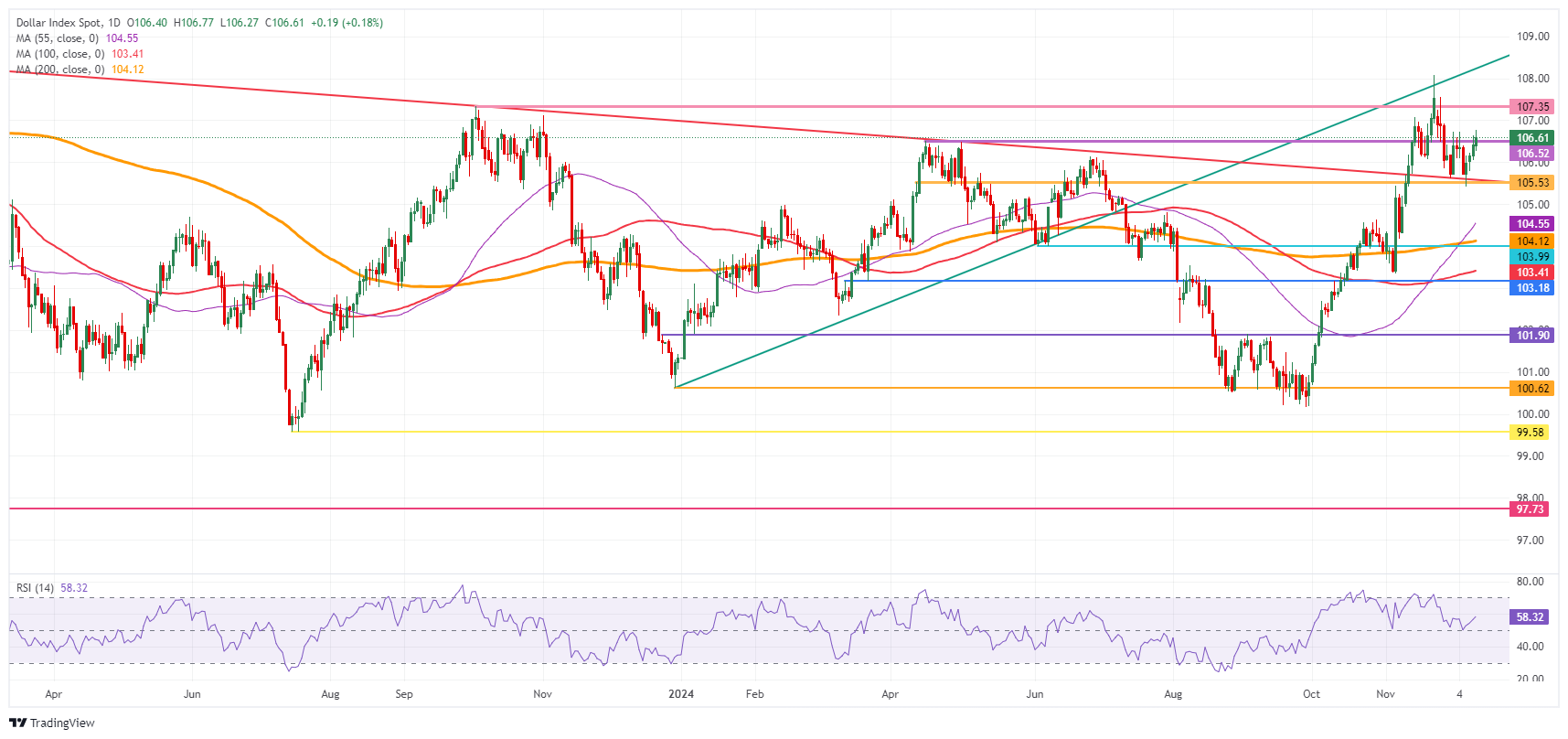US Dollar sees earlier gains erased after CPI is turning into nonevent

- The US Dollar falls back to flat after inflation gauge for November falls in line of expectations.
- Traders are boosting bets for a rate cut next week from the Fed
- The US Dollar Index (DXY) is trading near106.50 and falls back from 106.77 earlier.
The US Dollar (USD) is falling back to flat on Wednesday after the US Consumer Price Index (CPI) came broadly in line of expectations. No real outliers with the Monthly Headline Inflation coming in at 0.3% while the monthly Core Inflation measure ticked up by 0.3% as well. Immediately after the numbers, the Greenback eased and bets for a december rate cut increased.
All US data for this Wednesday are out of the way. Main focus will now shift to Thursday with the US Producer Price Index and the lighter Import/Export Price Index on Friday. On Thusday focus will shift to Europe, where the European Central Bank is set to deliver its last rate decision for 2024.
Daily digest market movers: CPI in line is good news for rate cut bets
- The US Consumer Price Index (CPI) release for November came in as no surprise:
- The monthly headline Inflation came in as expected at 0.3%, from 0.2%. The yearly gauge ticked up to 2.7% from 2.6%.
- The monthly core inflation increased by 0.3%, the same pace as the previous month. The yearly core measure was also steady at 3.3%.
- Equities are shrugging off their negative performance for this Wednesday. European equities are turning green while US equities are jumping higher.
- The CME FedWatch Tool is pricing in another 25 basis points (bps) rate cut by the Fed at the December 18 meeting by 86.1%. A 13.9% chance is for rates to remain unchanged.
- The US 10-year benchmark rate trades at 4.21%, retreating a touch from its peak this week at 4.24% on Tuesday.
US Dollar Index Technical Analysis: This is it for the rest of December
The US Dollar Index (DXY) is defining a bandwidth that could hold until next year given the limited amount of data points left. The US Consumer Price Index (CPI) release will likely determine if that bandwidth will be between 105.50 and 107.00 or between 105.50 and 108.00.
US Dollar bulls have reclaimed 106.52 (April 16 high), which was a hard bargain to get through. Next up is the 107.00 round level and 107.35 (October 3, 2023, high). Further up, the high of November 22 at 108.7 emerges.
Looking down, the pivotal level at 105.53 (April 11 high) comes into play before heading into the 104-region. Should the DXY fall all the way towards 104.00, the big figure and the 200-day Simple Moving Average at 104.03 should catch any falling knife formation.
US Dollar Index: Daily Chart
Inflation FAQs
Inflation measures the rise in the price of a representative basket of goods and services. Headline inflation is usually expressed as a percentage change on a month-on-month (MoM) and year-on-year (YoY) basis. Core inflation excludes more volatile elements such as food and fuel which can fluctuate because of geopolitical and seasonal factors. Core inflation is the figure economists focus on and is the level targeted by central banks, which are mandated to keep inflation at a manageable level, usually around 2%.
The Consumer Price Index (CPI) measures the change in prices of a basket of goods and services over a period of time. It is usually expressed as a percentage change on a month-on-month (MoM) and year-on-year (YoY) basis. Core CPI is the figure targeted by central banks as it excludes volatile food and fuel inputs. When Core CPI rises above 2% it usually results in higher interest rates and vice versa when it falls below 2%. Since higher interest rates are positive for a currency, higher inflation usually results in a stronger currency. The opposite is true when inflation falls.
Although it may seem counter-intuitive, high inflation in a country pushes up the value of its currency and vice versa for lower inflation. This is because the central bank will normally raise interest rates to combat the higher inflation, which attract more global capital inflows from investors looking for a lucrative place to park their money.
Formerly, Gold was the asset investors turned to in times of high inflation because it preserved its value, and whilst investors will often still buy Gold for its safe-haven properties in times of extreme market turmoil, this is not the case most of the time. This is because when inflation is high, central banks will put up interest rates to combat it. Higher interest rates are negative for Gold because they increase the opportunity-cost of holding Gold vis-a-vis an interest-bearing asset or placing the money in a cash deposit account. On the flipside, lower inflation tends to be positive for Gold as it brings interest rates down, making the bright metal a more viable investment alternative.
